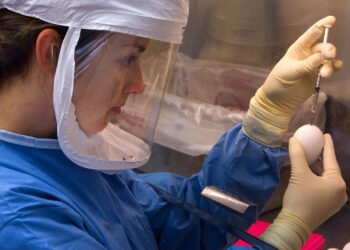TOPLINE:
Compared with standard-of-care practices according to the European Association for the Study of Diabetes (EASD) and American Diabetes Association (ADA) consensus report, telemonitoring with continuous glucose monitoring (CGM) and connected insulin pens improved glycaemic control in patients with type 2 diabetes (T2D), showing a 13.6% increase in the time in range for CGM.
METHODOLOGY:
- Researchers in Denmark conducted a clinical trial to assess the effectiveness and safety of telemonitoring among patients with T2D treated with insulin.
- They included 331 patients with a diagnosis of T2D for 12 months or more (mean age, 61.3 years; 61.6% men) and randomly assigned them to the telemonitoring or standard-of-care group over a 3-month period.
- The telemonitoring group used a continuous glucose monitor, a connected insulin pen, an activity tracker, and related smartphone applications; the clinical staff monitored their data and provided telephonic support at least three times during the trial and were capable to give advice on adjusting insulin doses after consulting a physician.
- The standard-of-care group received care according to the EASD-ADA consensus report; they used a continuous glucose monitor during the first and last 20 days of the trial and a connected insulin pen, with participants and the clinical staff having no access to data during the trial.
- The primary outcome measure was a change from baseline in the time in range for CGM (3.9-10.0 mmol/L), and secondary endpoints included changes from baseline in the A1c level, total daily insulin dose, and time both below and above range for CGM at 3 months.
TAKEAWAY:
- Compared with the standard-of-care group, the telemonitoring group demonstrated significantly superior glycaemic control with an estimated treatment difference of 13.6% in the time in range for CGM (P = .004).
- Compared with standard of care, telemonitoring significantly reduced the A1c level by 7.6 mmol/mol (P = .001).
- The time above range for CGM decreased by 13.1% (P = .004) in the telemonitoring vs standard-of-care groups, whereas no significant differences in the time below range for CGM and total daily insulin dose were found between groups.
- Even though no episodes of severe hypoglycaemia were reported in either group, two serious adverse events related to the trial occurred in the telemonitoring group, where participants injected excessive amounts of fast-acting insulin.
IN PRACTICE:
“Telemonitoring was superior to standard of care in T2D as it effectively and safely improved glycemic control. Future studies should explore the potential of intelligent clinical decision support in telemonitoring of people with T2D to exploit the large amount of data that diabetes technology will generate,” the authors wrote.
SOURCE:
This study was led by Stine Hangaard, Steno Diabetes Center North Denmark, Aalborg University Hospital, Aalborg, Denmark. It was published online on May 24, 2025, in European Journal of Internal Medicine.
LIMITATIONS:
The telemonitoring group’s access to CGM data with the standard-of-care group remaining blinded to them may have underestimated the treatment effect due to immediate behaviour changes. As this was a telemedicine trial, it was not possible to identify specific components of the intervention that contributed to the observed effects. Moreover, the study faced selection bias, as patients who were more comfortable using technology were more likely to participate in the trial.
DISCLOSURES:
This study received support from the ADAPT-T2D consortium, The Innovation Fund Denmark, and Novo Nordisk A/S. Six authors reported being employees of and having shares in Novo Nordisk A/S. Some others reported receiving consultant fees, unrestricted grants, and travel grants from various pharmaceutical companies.
This article was created using several editorial tools, including AI, as part of the process. Human editors reviewed this content before publication.
Source link : https://www.medscape.com/viewarticle/telemonitoring-boosts-glycaemic-control-t2d-2025a1000da6?src=rss
Author :
Publish date : 2025-05-29 12:00:00
Copyright for syndicated content belongs to the linked Source.














